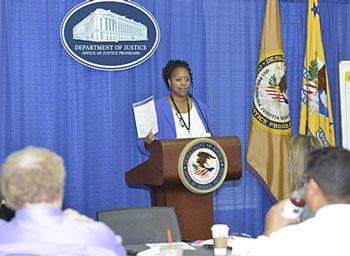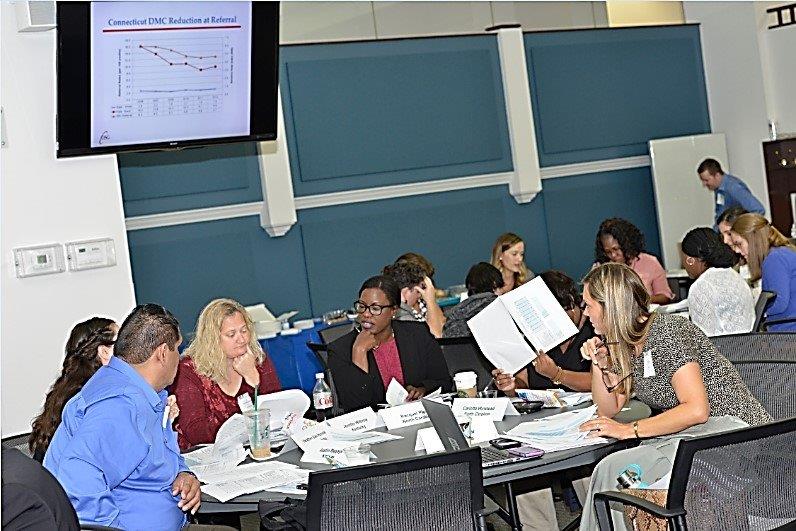 Tina Borner, Senior OJJDP Compliance Analyst, addresses the attendees. OJJDP designed the trainings, which took place in Washington, DC, on September 12–15, 2017, to support state compliance with the core requirements of the Juvenile Justice and Delinquency Prevention Act.
Tina Borner, Senior OJJDP Compliance Analyst, addresses the attendees. OJJDP designed the trainings, which took place in Washington, DC, on September 12–15, 2017, to support state compliance with the core requirements of the Juvenile Justice and Delinquency Prevention Act. SAG New Member Training
The 56 State Advisory Groups are responsible for participating in the development and review of their state’s juvenile justice plan; reviewing and commenting on applications for subgrants; advising the designated state agency, chief executive, and state legislature on their states’ compliance with the requirements of the JJDP Act; and obtaining regular input from youth currently under justice system jurisdiction.
On September 12, Chyrl Jones, Deputy Administrator, opened the SAG training session. She welcomed participants and provided an overview of OJJDP’s partnership with the states to address the JJDP Act’s four core requirements: deinstitutionalization of status offenders (DSO), removal of youth from adult jails and detention facilities, prohibition of sight or sound contact of juveniles with adult inmates, and a reduction in the disproportionate number of minority youth who come into contact with the juvenile justice system. Deputy Administrator Jones then introduced OJJDP Acting Administrator Eileen M. Garry, who discussed the important role of SAG members and her commitment to continuing to strengthen OJJDP’s partnership with the states. Acting Administrator Garry also offered examples of effective and innovative work that states are undertaking.
Robin Delany-Shabazz, Associate Administrator of OJJDP’s State and Community Development (SCD) Division, spoke about the history of the JJDP Act, OJJDP’s mission, and how the Office’s SCD and Core Protections Divisions help the states achieve compliance with the core requirements. SCD administers the Formula Grants program, which supports state and local delinquency prevention and intervention efforts and juvenile justice system improvements. The Core Protections Division conducts audits to assess compliance monitoring system adequacy, makes annual determinations of compliance with the core requirements, and coordinates with OJJDP staff and training and technical assistance providers to ensure that states receive the necessary assistance.
In a session titled “Working Together for Our Children,” OJJDP Program Manager Karen Bachar and Utah SAG Chair Pam Vickery led a discussion on the roles and responsibilities of SAG members. Among other responsibilities, SAG members must participate in the development of a 3-year strategic plan to qualify for Formula Grants funding, submit annual recommendations to the Governor and state legislature, and seek regular input from youth under juvenile justice jurisdiction. The discussion emphasized the importance of the SAG Chair and the Juvenile Justice Specialist in each state working together closely to identify gaps, needs, and goals.
Other topics covered in the training included the importance of data collection and analysis, an overview of the 3-year plan and formula grants application process, and strategies for engaging youth. Ms. Bachar and Ms. Vickery also joined Naomi Smoot, Executive Director of the Coalition for Juvenile Justice, to discuss how SAG members can be active, effective juvenile justice leaders in their states.
DMC Coordinator Training
Disproportionate minority contact coordinators are responsible for facilitating their states’ compliance with the DMC core requirement through comprehensive DMC-related data collection, reviews of statewide initiatives, and dissemination of information. OJJDP’s September 13 training included the following information—
- An overview of DMC and racial and ethnic disparities, including the core DMC requirement.
- The roles and responsibilities of key stakeholders.
- OJJDP’s five-phase DMC Reduction Model, which helps states determine whether disproportionality exists within their jurisdictions and, if it does, provides a step-by-step model to guide their DMC reduction efforts.
Compliance Monitor Training 
Compliance monitors are responsible for supporting their states’ compliance with other core requirements of the JJDP Act—deinstitutionalization of status offenders, sight and sound separation, and jail and lockup removal. On September 14–15, OJJDP Senior Advisor Greg Thompson and Senior Compliance Analyst Julie Herr reviewed new regulatory guidance and provided an overview of the following requirements:
- Deinstitutionalization of status offenders: The definition of a status offender (a status offender is a juvenile who has been charged with, or adjudicated for, conduct that would not be a crime if committed by an adult); examples of status offenses (e.g., running away, curfew Representatives from more than 50 U.S. states and territories participated in the in-person and webinar-facilitated trainings. The collaborative, peer-to-peer learning environment of the trainings allowed the more experienced attendees to share lessons learned with their newer counterparts. violations, truancy); and exceptions to the DSO requirement, including the valid court order.
- Sight and sound separation: An explanation of sight separation (prohibiting clear visual contact between adult inmates and juveniles) and sound separation (prohibiting direct oral communication between adult inmates and juvenile offenders).
- Jail and lockup removal: A description of this requirement (that no juvenile will be detained or confined in any jail or lockup for adults) and the four exceptions to the requirement (the 6-hour, rural, travel conditions, and conditions of safety exceptions).
OJJDP staff also discussed the statutory language surrounding the detention and confinement of youth, provided an overview of the compliance determination process, and explained how the Core Protections Division uses the Compliance Determination Assessment Form to inform the compliance determination this process.
“OJJDP is committed to strengthening its relationship with states, and we hope this training offered valuable information to support compliance with the requirements of the JJDP Act,” said OJJDP Acting Administrator Eileen M. Garry. “The Office has a wealth of resources to assist in this effort.”
Resources:
More information on compliance with the JJDP Act and the Formula Grants program is available on the Office’s website. Contact information for the juvenile justice specialists, DMC coordinators, and SAG chairs in each state may also be accessed on the OJJDP website.
To read a 2017 state-by-state summary of juvenile justice initiatives, visit the website of the Federal Advisory Committee on Juvenile Justice.
